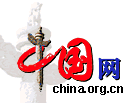Organizers of a national art exhibition have been accused of insulting one of China's most important artists.
A display of paintings by Jiang Zhaohe has been described as a 'total mess' by visitors.
The exhibition to commemorate the 100th anniversary of Jiang's birth opened on Saturday at the National Art Museum of China (NAMOC) in Beijing, and has been organized by the Chinese Artists' Association.
But the old master's paintings have been poorly hung and labeled in such a confusing way that visitors cannot tell whether many of the exhibits are originals, copies or photos. "It's heart-aching to see this wonderful art in such a poorly organized exhibition. It's almost an insult to the master," said Han Mo, a Beijing-based art scholar.
Hu Yanming, one of the first visitors through the doors was more abrupt in his critique. "The place looks like a total mess," he said. The week-long event features more than 40 ink paintings and sketches by Jiang, who was born in Beijing in 1904 and died 1986.
It even includes his famous giant-sized "Portrait of Refugees" (Liumin Tu), which depicts Chinese refugees running for their lives from Japanese invaders during the War of Resistance against Japan (1937-45).
The piece is "the most precious artwork in the collection of the national art museum," said Yang Lizhou, a renowned artist and former director of the NAMOC.
Another masterpiece, titled "Portrait of A Q," is also on display.
"His works display the full emotion and the suffering at the grassroot level during wartime China," said Yang.
But the greatness of his work has been lost among the haphazardness. The "confusing" exhibition has the paintings "hung in such a random way" ensuring that "all authenticity is lost."
Jiang's sketches and oil paintings are celebrated because "they give a realistic touch."
Parts of Jiang's diary writings are often quoted by members of China's arts community.
"Few people know me and even fewer love me. Only the poor can understand my paintings, as I sympathize at the bodies of the starved on roadsides," is one such revered paragraph, written by Jiang in 1940.
He also wrote, somewhat ironically, of his art: "I know that some want a nice cup of wine from life, but others may need a bowl of bitter tea to quench their thirst. I don't know whether art should be wine or bitter tea. I am trying my best to boil for the public a bowl of tea."
Unfortunately, many art lovers are currently leaving the National Art Museum with a bitter taste in their mouths.
(China Daily September 7, 2004)

